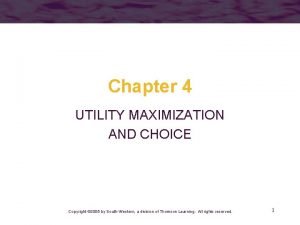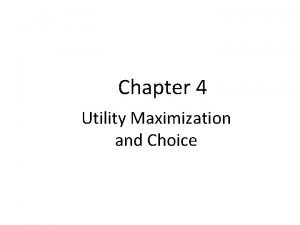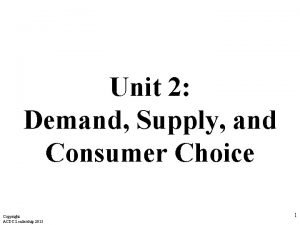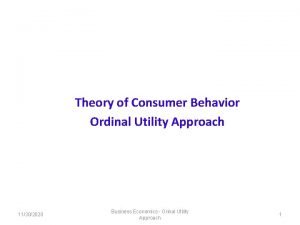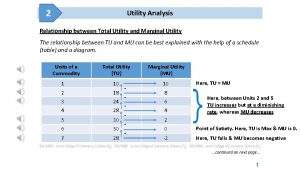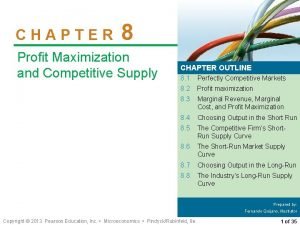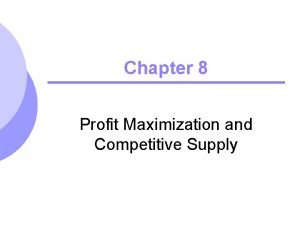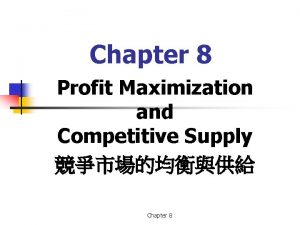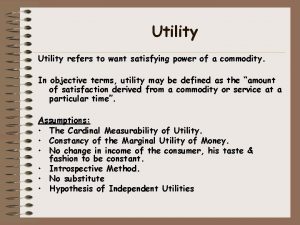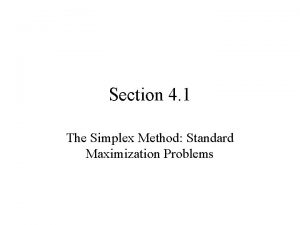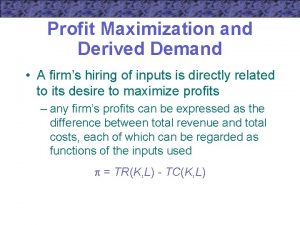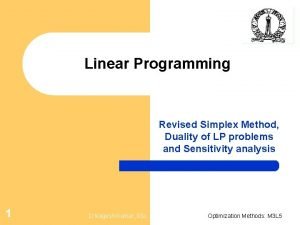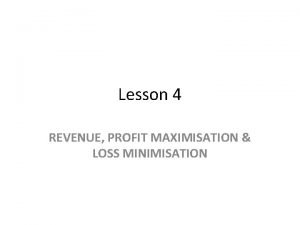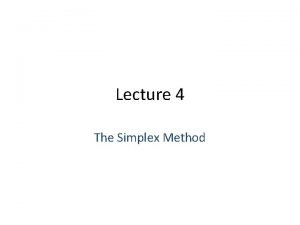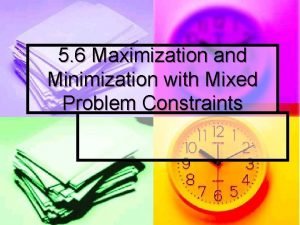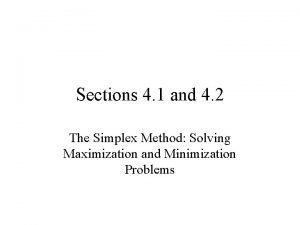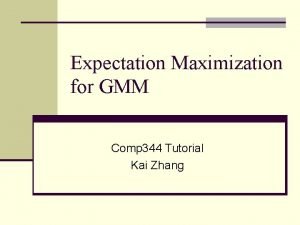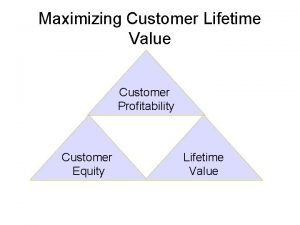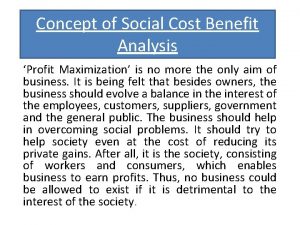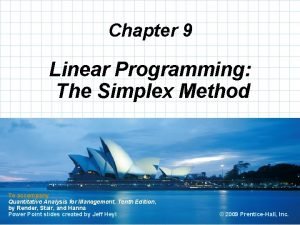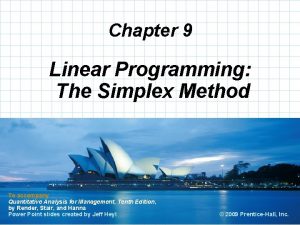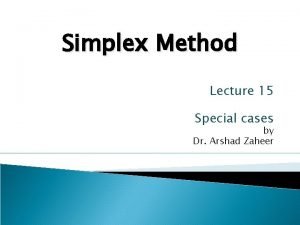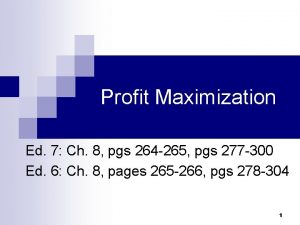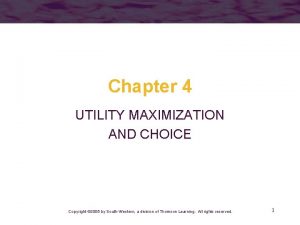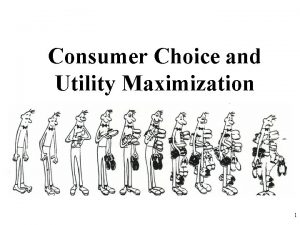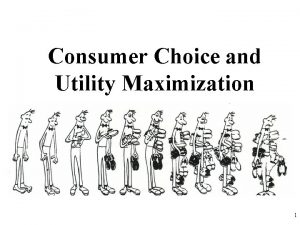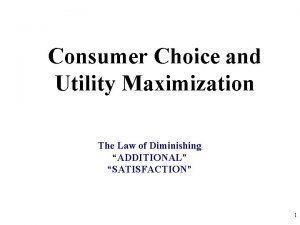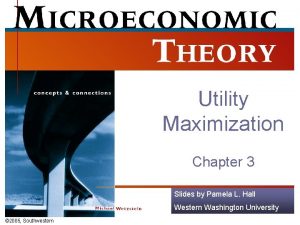Utility Maximization and Choice Power Point Slides prepared






































- Slides: 38

Utility Maximization and Choice Power. Point Slides prepared by: Andreea CHIRITESCU, Eastern Illinois University; Modified by: Ronald WENDNER, University of Graz, Austria © 2012 Cengage Learning. All Rights Reserved. May not be copied, scanned, or duplicated, in whole or in part, except for use as permitted in a license distributed with a certain product or service or otherwise on a password-protected website for classroom use. 1

The Plan • Utility maximization (☞ Marshallian demand) • Two-good case • N-good case • Indirect utility function • Expenditure minimization (☞ Hicksian demand) • Expenditure function © 2012 Cengage Learning. All Rights Reserved. May not be copied, scanned, or duplicated, in whole or in part, except for use as permitted in a license distributed with a certain product or service or otherwise on a password-protected website for classroom use. 2

The Two-Good Case • Individual chooses among 2 goods – Budget: I dollars to allocate between good x and good y – px - price of good x – py - price of good y • Budget constraint: pxx + pyy ≤ I – Slope = -px/py – If all of I is spent on good x, buy I/px units of good x – Query: How many units if all I is spent on good y? What are the exogenous/endogenous vars? © 2012 Cengage Learning. All Rights Reserved. May not be copied, scanned, or duplicated, in whole or in part, except for use as permitted in a license distributed with a certain product or service or otherwise on a password-protected website for classroom use. 4

4. 1 The Individual’s Budget Constraint for Two Goods Quantity of y I=pxx+pyy Quantity of x Those combinations of x and y that the individual can afford are shown in the shaded triangle. The slope of this straight-line boundary is given by –px/py. Query. Properties of budget set © 2012 Cengage Learning. All Rights Reserved. May not be copied, scanned, or duplicated, in whole or in part, except for use as permitted in a license distributed with a certain product or service or otherwise on a password-protected website for classroom use. 5

The Two-Good Case • First-order conditions for a maximum – Point of tangency between the budget constraint and the indifference curve: © 2012 Cengage Learning. All Rights Reserved. May not be copied, scanned, or duplicated, in whole or in part, except for use as permitted in a license distributed with a certain product or service or otherwise on a password-protected website for classroom use. 6

4. 2 A Graphical Demonstration of Utility Maximization Quantity of y B D C y* I=pxx+pyy U 3 A U 2 U 1 x* Quantity of x Point C represents the highest utility level that can be reached by the individual, given the budget constraint. Therefore, the combination x*, y* is the rational way for the individual to allocate purchasing power. Only for this combination of goods will two conditions hold: All available funds will be spent, and the individual’s psychic rate of trade-off (MRS) will be equal to the rate at which the goods can be traded in the market ( px/py). © 2012 Cengage Learning. All Rights Reserved. May not be copied, scanned, or duplicated, in whole or in part, except for use as permitted in a license distributed with a certain product or service or otherwise on a password-protected website for classroom use. 7

The Two-Good Case • The tangency rule – Is not sufficient • If MRS is not diminishing, we must check second-order conditions to ensure that we are at a maximum • What about points A and D in the previous figure? – Query. Is tangency rule necessary? © 2012 Cengage Learning. All Rights Reserved. May not be copied, scanned, or duplicated, in whole or in part, except for use as permitted in a license distributed with a certain product or service or otherwise on a password-protected website for classroom use. 8

4. 3 Example of an Indifference Curve Map for Which the Tangency Condition Does Not Ensure a Maximum Quantity of y C A B U 1 U 2 U 3 Quantity of x Query. What about perfect substitutes? Give a graphical illustration. © 2012 Cengage Learning. All Rights Reserved. May not be copied, scanned, or duplicated, in whole or in part, except for use as permitted in a license distributed with a certain product or service or otherwise on a password-protected website for classroom use. 9

The Two-Good Case • Corner (boundary) solutions – Individuals may maximize utility by choosing to consume only one of the goods – Query. At the optimal point, is the budget constraint flatter/steeper than the indifference curve? • Think about (x, 0) respectively (0, y) being the optimal consumption bundles. – Query. Possible that Individuals may maximize utility by choosing none of the goods? © 2012 Cengage Learning. All Rights Reserved. May not be copied, scanned, or duplicated, in whole or in part, except for use as permitted in a license distributed with a certain product or service or otherwise on a password-protected website for classroom use. 10

4. 4 Corner (Boundary) Solution for Utility Maximization Quantity of y U 1 U U 3 2 x* Quantity of x With the preferences represented by this set of indifference curves, utility maximization occurs at E, where 0 amounts of good y are consumed. The first-order conditions for a maximum must be modified somewhat to accommodate this possibility. Query. What happens when the indifference curves are everywhere flatter than px/py? © 2012 Cengage Learning. All Rights Reserved. May not be copied, scanned, or duplicated, in whole or in part, except for use as permitted in a license distributed with a certain product or service or otherwise on a password-protected website for classroom use. 11

The n-Good Case (Lagrange method) • The individual’s objective is to maximize utility = U(x 1, x 2, …, xn) subject to the budget constraint I = p 1 x 1 + p 2 x 2 +…+ pnxn • Set up the Lagrangian: ℒ = U(x 1, x 2, …, xn) + λ(I - p 1 x 1 - p 2 x 2 -…- pnxn) • Query. Interpret the Lagrange multiplier © 2012 Cengage Learning. All Rights Reserved. May not be copied, scanned, or duplicated, in whole or in part, except for use as permitted in a license distributed with a certain product or service or otherwise on a password-protected website for classroom use. 12

The n-Good Case • (n+1) first-order conditions for an interior maximum ∂ℒ/∂x 1 = ∂U/∂x 1 - λp 1 = 0 ∂ℒ /∂x 2 = ∂U/∂x 2 - λp 2 = 0 … ∂ℒ /∂xn = ∂U/∂xn - λpn = 0 ∂ℒ /∂λ= I - p 1 x 1 - p 2 x 2 - … - pnxn = 0 © 2012 Cengage Learning. All Rights Reserved. May not be copied, scanned, or duplicated, in whole or in part, except for use as permitted in a license distributed with a certain product or service or otherwise on a password-protected website for classroom use. 13

The n-Good Case • Implications of first-order conditions – For any two goods, xi and xj: © 2012 Cengage Learning. All Rights Reserved. May not be copied, scanned, or duplicated, in whole or in part, except for use as permitted in a license distributed with a certain product or service or otherwise on a password-protected website for classroom use. 14

The n-Good Case • Interpreting the Lagrange multiplier – λ is the marginal utility of an extra dollar of consumption expenditure (of income) © 2012 Cengage Learning. All Rights Reserved. May not be copied, scanned, or duplicated, in whole or in part, except for use as permitted in a license distributed with a certain product or service or otherwise on a password-protected website for classroom use. 15

The n-Good Case • © 2012 Cengage Learning. All Rights Reserved. May not be copied, scanned, or duplicated, in whole or in part, except for use as permitted in a license distributed with a certain product or service or otherwise on a password-protected website for classroom use. 16

The n-Good Case • Corner solutions (Kuhn-Tucker conditions) – Means that the first-order conditions must be modified: ∂ℒ/∂xi = ∂U/∂xi - λpi ≤ 0 (i = 1, …, n) – If ∂ℒ/∂xi = ∂U/∂xi - λpi < 0, then xi = 0 – This means that – any good whose price exceeds its marginal value to the consumer will not be purchased © 2012 Cengage Learning. All Rights Reserved. May not be copied, scanned, or duplicated, in whole or in part, except for use as permitted in a license distributed with a certain product or service or otherwise on a password-protected website for classroom use. 17

4. 1 Cobb–Douglas Demand Functions • Cobb-Douglas utility function: U(x, y) = xαyβ • Setting up the Lagrangian: ℒ = xαyβ+ λ(I - pxx - pyy) • First-order conditions: ∂ℒ/∂x = αxα-1 yβ- λpx = 0 ∂ℒ/∂y = βxαyβ-1 - λpy = 0 ∂ℒ/∂λ= I - pxx - pyy = 0 © 2012 Cengage Learning. All Rights Reserved. May not be copied, scanned, or duplicated, in whole or in part, except for use as permitted in a license distributed with a certain product or service or otherwise on a password-protected website for classroom use. 18

4. 1 Cobb–Douglas Demand Functions • First-order conditions imply: αy/βx = px/py • If α+ β= 1: pyy = (β/α)pxx = [(1 - α)/α]pxx • Substituting into the budget constraint: I = pxx + [(1 - α)/α]pxx = (1/α)pxx • Solving: x*=αI/px and y*=βI/py • The individual will allocate α percent of his income to good x and β percent of his income to good y © 2012 Cengage Learning. All Rights Reserved. May not be copied, scanned, or duplicated, in whole or in part, except for use as permitted in a license distributed with a certain product or service or otherwise on a password-protected website for classroom use. 19

4. 1 Cobb–Douglas Demand Functions • Cobb-Douglas utility function • Is limited in its ability to explain actual consumption behavior • The share of income devoted to a good often changes in response to changing economic conditions • A more general functional form might be more useful © 2012 Cengage Learning. All Rights Reserved. May not be copied, scanned, or duplicated, in whole or in part, except for use as permitted in a license distributed with a certain product or service or otherwise on a password-protected website for classroom use. 20

4. 2 CES Demand • Assume that δ= 0. 5 U(x, y) = x 0. 5 + y 0. 5 • Setting up the Lagrangian: ℒ = x 0. 5 + y 0. 5 + λ(I - pxx - pyy) • First-order conditions for a maximum: ∂ℒ/∂x = 0. 5 x -0. 5 - λpx = 0 ∂ℒ/∂y = 0. 5 y -0. 5 - λpy = 0 ∂ℒ/∂λ= I - pxx - pyy = 0 © 2012 Cengage Learning. All Rights Reserved. May not be copied, scanned, or duplicated, in whole or in part, except for use as permitted in a license distributed with a certain product or service or otherwise on a password-protected website for classroom use. 21

4. 2 CES Demand • This means that: (y/x)0. 5 = px/py • Substituting into the budget constraint, we can solve for the demand functions • The share of income spent on either x or y is not a constant • Depends on the ratio of the two prices • The higher is the relative price of x, the smaller will be the share of income spent on x © 2012 Cengage Learning. All Rights Reserved. May not be copied, scanned, or duplicated, in whole or in part, except for use as permitted in a license distributed with a certain product or service or otherwise on a password-protected website for classroom use. 22

4. 2 CES Demand • If δ= -1, U(x, y) = -x -1 - y -1 • First-order conditions imply that y/x = (px/py)0. 5 • The demand functions are © 2012 Cengage Learning. All Rights Reserved. May not be copied, scanned, or duplicated, in whole or in part, except for use as permitted in a license distributed with a certain product or service or otherwise on a password-protected website for classroom use. 23

4. 2 CES Demand • If δ= -∞, U(x, y) = Min(x, 4 y) • The person will choose only combinations for which x = 4 y • This means that I = pxx + pyy = pxx + py(x/4) I = (px + 0. 25 py)x • The demand functions are © 2012 Cengage Learning. All Rights Reserved. May not be copied, scanned, or duplicated, in whole or in part, except for use as permitted in a license distributed with a certain product or service or otherwise on a password-protected website for classroom use. 24

Indirect Utility Function • manipulate first-order conditions to solve for optimal x 1, x 2, …, xn – Marshallian demand functions x*1 = x 1(p 1, p 2, …, pn, I) x*2 = x 2(p 1, p 2, …, pn, I) … x*n = xn(p 1, p 2, …, pn, I) © 2012 Cengage Learning. All Rights Reserved. May not be copied, scanned, or duplicated, in whole or in part, except for use as permitted in a license distributed with a certain product or service or otherwise on a password-protected website for classroom use. 25

Indirect Utility Function • We can use the optimal values of the x’s to find the indirect utility function maximum utility = U[x*1(p 1, p 2, …, pn, I), x*2(p 1, p 2, …, pn, I), …, x*n(p 1, p 2, …, pn, I)] = = V(p 1, p 2, …, pn, I) • The optimal level of utility will depend indirectly on prices and income • Indirect utility is a function of prices and income Query. Find important properties of V(p, I) © 2012 Cengage Learning. All Rights Reserved. May not be copied, scanned, or duplicated, in whole or in part, except for use as permitted in a license distributed with a certain product or service or otherwise on a password-protected website for classroom use. 26

4. 3 Indirect Utility • Cobb-Douglas utility function • With α= β= 0. 5 x*=I/2 px and y*=I/2 py • The indirect utility function © 2012 Cengage Learning. All Rights Reserved. May not be copied, scanned, or duplicated, in whole or in part, except for use as permitted in a license distributed with a certain product or service or otherwise on a password-protected website for classroom use. 29

4. 3 Indirect Utility and the Lump Sum Principle • Fixed proportions x*=I/[px + 0. 25 py] and y*=I/[4 px+py] • The indirect utility function I © 2012 Cengage Learning. All Rights Reserved. May not be copied, scanned, or duplicated, in whole or in part, except for use as permitted in a license distributed with a certain product or service or otherwise on a password-protected website for classroom use. 30

Expenditure Minimization • Utility maximization problem (UMP) • Dual problem: EMP (expenditure minimization problem) – Allocate income to achieve a given level of utility with the minimal expenditure • The goal and the constraint have been reversed © 2012 Cengage Learning. All Rights Reserved. May not be copied, scanned, or duplicated, in whole or in part, except for use as permitted in a license distributed with a certain product or service or otherwise on a password-protected website for classroom use. 33

4. 6 The Dual Expenditure-Minimization Problem E 2 Quantity of y E 3 B E 1 y* A C U 2 x* Quantity of x The dual of the utility-maximization problem is to attain a given utility level (U 2) with minimal expenditures. An expenditure level of E 1 does not permit U 2 to be reached, whereas E 3 provides more spending power than is strictly necessary. With expenditure E 2, this person can just reach U 2 by consuming x and y. © 2012 Cengage Learning. All Rights Reserved. May not be copied, scanned, or duplicated, in whole or in part, except for use as permitted in a license distributed with a certain product or service or otherwise on a password-protected website for classroom use. 34

Expenditure Minimization • UMP – – Objective function: utility function Constraint: income Domain (opportunity/choice set): budget set Solution: Marshallian demand function • Dual EMP – Objective function: total expenditures – Constraint: utility – Domain (opportunity/choice set): upper level sets (at least as good sets in the consumption set) – Solution: Hicksian demand functions © 2012 Cengage Learning. All Rights Reserved. May not be copied, scanned, or duplicated, in whole or in part, except for use as permitted in a license distributed with a certain product or service or otherwise on a password-protected website for classroom use. 35

Expenditure Minimization • The individual’s problem is to choose x 1, x 2, …, xn to minimize total expenditures = E = p 1 x 1 + p 2 x 2 +…+ pnxn subject to the constraint utility = Ū = U(x 1, x 2, …, xn) – The optimal amounts of x 1, x 2, …, xn (Hicksian demand functions) will depend on the prices of the goods and the required utility level © 2012 Cengage Learning. All Rights Reserved. May not be copied, scanned, or duplicated, in whole or in part, except for use as permitted in a license distributed with a certain product or service or otherwise on a password-protected website for classroom use. 36

Expenditure Minimization • Solution: Hicksian demand functions xi(p 1, p 2, …, pn, U) • Expenditure function – E(p 1, p 2, …, pn, U) = = p 1 x 1(p 1, p 2, …, pn, U)+ p 2 x 2(p 1, p 2, …, pn, U)+…. – Minimal expenditure to achieve utility level U Query. What are endogenous and exogenous variables in the EMP? © 2012 Cengage Learning. All Rights Reserved. May not be copied, scanned, or duplicated, in whole or in part, except for use as permitted in a license distributed with a certain product or service or otherwise on a password-protected website for classroom use. 37

Expenditure Minimization • The expenditure function and the indirect utility function – Are inversely related – Both depend on market prices – But involve different constraints • Query. Identify the constraints of the UMP and EMP respectively. © 2012 Cengage Learning. All Rights Reserved. May not be copied, scanned, or duplicated, in whole or in part, except for use as permitted in a license distributed with a certain product or service or otherwise on a password-protected website for classroom use. 38

4. 4 Two Expenditure Functions • Cobb-Douglas • The indirect utility function in the two-good case: • If we interchange the role of utility and income (expenditure), we will have the expenditure function E(px, py, U) = 2 px 0. 5 py 0. 5 U © 2012 Cengage Learning. All Rights Reserved. May not be copied, scanned, or duplicated, in whole or in part, except for use as permitted in a license distributed with a certain product or service or otherwise on a password-protected website for classroom use. 39

4. 4 Two Expenditure Functions • Fixed-proportions case • The indirect utility function: • If we interchange the role of utility and income (expenditure), we will have the expenditure function E(px, py, U) = (px + 0. 25 py)U © 2012 Cengage Learning. All Rights Reserved. May not be copied, scanned, or duplicated, in whole or in part, except for use as permitted in a license distributed with a certain product or service or otherwise on a password-protected website for classroom use. 40

Properties of Expenditure Functions • Homogeneity – A doubling of all prices will precisely double the value of required expenditures • Homogeneous of degree one in prices • Nondecreasing in prices – ∂E/∂pi ≥ 0 for every good • Concave in prices – Functions that always lie below tangents to them © 2012 Cengage Learning. All Rights Reserved. May not be copied, scanned, or duplicated, in whole or in part, except for use as permitted in a license distributed with a certain product or service or otherwise on a password-protected website for classroom use. 41

4. 7 Expenditure Functions Are Concave in Prices E(p 1, …) Epseudo E(p 1, …) E(p*1, …) p*1 p 1 At p 1 this person spends E(p 1* , . . . ). If he or she continues to buy the same set of goods as p 1 changes, then expenditures would be given by Epseudo. Because his or her consumption patterns will likely change as p 1 changes, actual expenditures will be less than this. © 2012 Cengage Learning. All Rights Reserved. May not be copied, scanned, or duplicated, in whole or in part, except for use as permitted in a license distributed with a certain product or service or otherwise on a password-protected website for classroom use. 42

EMP and UMP • Solutions to the UMP and the EMP – Marshallian demand functions xi(p 1, p 2, …, pn, I) – Hicksian demand functions xi(p 1, p 2, …, pn, U) – – Query. What exactly do Hicksian demand functions identify? What exactly do Marshallien demand functions identify? Relate xi(p 1, p 2, …, pn, U) to xi(p 1, p 2, …, pn, I) © 2012 Cengage Learning. All Rights Reserved. May not be copied, scanned, or duplicated, in whole or in part, except for use as permitted in a license distributed with a certain product or service or otherwise on a password-protected website for classroom use. 43
 Utility maximization problem
Utility maximization problem Perfect substitutes utility function
Perfect substitutes utility function Utility maximization
Utility maximization Ordinal utility and cardinal utility
Ordinal utility and cardinal utility Relation between marginal utility and total utility
Relation between marginal utility and total utility A small child slides down the four frictionless slides
A small child slides down the four frictionless slides A child is on a playground swing motionless
A child is on a playground swing motionless Good choice or bad choice
Good choice or bad choice Triangle of power
Triangle of power Power bi training powerpoint
Power bi training powerpoint Profit maximization and competitive supply
Profit maximization and competitive supply Cost revenue and profit maximization guided reading
Cost revenue and profit maximization guided reading Profit maximizing output
Profit maximizing output Profit maximization and competitive supply
Profit maximization and competitive supply Point point power
Point point power Utility means want-satisfying power
Utility means want-satisfying power List three examples of in-transit foodservice operations.
List three examples of in-transit foodservice operations. Standard maximization problem
Standard maximization problem Monopsony profit maximization
Monopsony profit maximization Limitations of profit maximization
Limitations of profit maximization Dual simplex method maximization problem
Dual simplex method maximization problem Profit maximization
Profit maximization Slack variable example
Slack variable example Normal profit economics
Normal profit economics Big m method maximization
Big m method maximization Kalkulator metode simpleks
Kalkulator metode simpleks Module 53 featured worksheet profit maximization
Module 53 featured worksheet profit maximization Wealth maximization
Wealth maximization Expectation maximization tutorial
Expectation maximization tutorial Maximizing customer lifetime value
Maximizing customer lifetime value Define financial management
Define financial management Social cost
Social cost What cj-zj represents
What cj-zj represents What cj-zj represents
What cj-zj represents Expectation maximization algorithm
Expectation maximization algorithm Special cases in simplex method
Special cases in simplex method Profit maximizing quantity graph
Profit maximizing quantity graph Profit maximization
Profit maximization Ueeneeg171a
Ueeneeg171a
